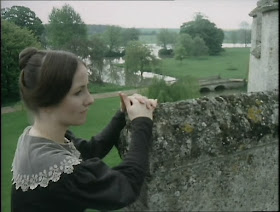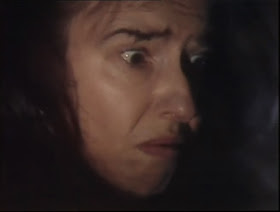Charlotte Brontë (21 April 1816 – 31 March 1855) was an English novelist and poet, the eldest of the three Brontë sisters, whose novels are English literature standards. She wrote Jane Eyre under the pen name Currer Bell.
Charlotte was born in Thornton, Yorkshire in 1816, the third of six children, to Maria (née Branwell) and her husband Patrick Brontë (formerly surnamed Brunty or Prunty), an Irish Anglican clergyman. In 1820, the family moved a few miles to Haworth, where Patrick had been appointed Perpetual Curate. Mrs. Brontë died of cancer on 15 September 1821, leaving five daughters and a son to be taken care of by her aunt Elizabeth Branwell. In August 1824, Charlotte was sent with three of her sisters, Emily, Maria, and Elizabeth, to the Clergy Daughters' School at Cowan Bridge in Lancashire (which she would describe as Lowood School in Jane Eyre). Its poor conditions, Charlotte maintained, permanently affected her health and physical development and hastened the deaths of her two elder sisters, Maria (born 1814) and Elizabeth (born 1815), who died of tuberculosis in June 1825. Soon after their father removed them from the school.
In June 1854, Charlotte married Arthur Bell Nicholls, her father's curate and, in the opinion of many scholars, the model for several of her literary characters such as Jane Eyre's Rochester and St. John. She became pregnant soon after the marriage. Her health declined rapidly during this time, and according to Gaskell, her earliest biographer, she was attacked by "sensations of perpetual nausea and ever-recurring faintness." Charlotte died, along with her unborn child, on 31 March 1855, at the young age of 38. Her death certificate gives the cause of death as phthisis (tuberculosis), but many biographers suggest she may have died from dehydration and malnourishment, caused by excessive vomiting from severe morning sickness or hyperemesis gravidarum. There is also evidence to suggest that Charlotte died from typhus she may have caught from Tabitha Ackroyd, the Brontë household's oldest servant, who died shortly before her. Charlotte was interred in the family vault in The Church of St. Michael and All Angels, Haworth, West Yorkshire, England.
Jane Eyre
Jane Eyre is a famous and influential novel by English writer Charlotte Brontë. It was published in London, England, in 1847 by Smith, Elder & Co. with the title Jane Eyre. An Autobiography under the pen name "Currer Bell," the "autobiography's" supposed editor. The first American edition was released the following year by Harper & Brothers of New York. The Penguin edition describes it as an "influential feminist text" because of its in-depth exploration of a strong female character's feelings.
The novel merges elements of three distinct genres. It has the form of a Bildungsroman, a story about a child's maturation, focusing on the emotions and experiences that accompany growth to adulthood. The novel also contains much social criticism, with a strong sense of morality at its core, and finally has the brooding and moody quality and Byronic character typical of Gothic fiction.
It is a novel often considered ahead of its time due to its portrayal of the development of a thinking and passionate young woman who is both individualistic, desiring for a full life, while also highly moral. Jane evolves from her beginnings as a poor and plain woman without captivating charm to her mature stage as a compassionate and confident whole woman. As she matures, she comments much on the complexities of the human condition. Jane also has a deeply pious personal trust in God, but is also highly self-reliant. Although Jane suffers much, she is never portrayed as a damsel in distress who needs rescuing. For this reason, it is sometimes regarded as an important early feminist (or proto-feminist) novel.
Jane Eyre is a first-person narrative of the title character. The novel goes through five distinct stages: Jane's childhood at Gateshead, where she is emotionally and physically abused by her aunt and cousins; her education at Lowood School, where she acquires friends and role models but also suffers privations and oppression; her time as the governess of Thornfield Hall, where she falls in love with her Byronic employer, Edward Rochester; her time with the Rivers family during which her earnest but cold clergyman-cousin St John Rivers proposes to her; and the finale with her reunion with and marriage to her beloved Rochester.
Jane Eyre is divided into 38 chapters and most editions are at least 400 pages long (although the preface and introduction on certain copies are liable to take up another 100). The original was published in three volumes, comprising chapters 1 to 15, 16 to 26, and 27 to 38; this was a common publishing format during the 19th century, see Three-volume novel.
Brontë dedicated the novel's second edition to William Makepeace Thackeray.
Paul Reade ~ Jane Eyre (1983) |BBC Soundtrack|
Original Release Date: 9 October 1983, England, UK
CD, Album HD 1/1
Genre: Classical, Instrumental, TV, Soundtrack
Label: BBC Music
BBC © MMX
© British Broadcasting Corporation (BBC)
~~~~~~~~
Tracklist:
~~~~~~~~
~~~~~~~~~~~~~~~~~
1 Open Theme |0:46
2 End Titles |1:15
3 Jane Eyre's Theme |1:50
Total Time: 3:52
~~~~~~~~~~~~~~~~~~~~~~~~~~~~~~~~~~~~~~
| DDD | Audio CD | CBR 320 Kbps/48.1 kHz/Stereo |
| File Size: 13,2 mb. | Pass: janeeyre |
Composed, Conducted by Paul Reade
BBC Philharmonic Orchestra
~~~~~~~~~~
Here: MedFire!
~~~~~~~~~~
BBC Sites!
Charlotte's most famous novel depicts the emotional and spiritual development of the heroine, which is mirrored by her physical journeyings throughout the book. It describes her search for self-worth, for identity as an individual and for economic independence, in a world which did not expect such ambitions in women.
Jane first appears as an orphaned child, lodged with an aunt who resents her and shamelessly favours her own children. She is sent away to a charity school run by Mr Brocklehurst, where, through the harsh regime, she learns survival and eventually succeeds in becoming a teacher there herself. She advertises for a post as governess, and is appointed to care for Adele, the ward of the sardonic Edward Rochester at Thornfield Hall. Thus far, Charlotte is drawing heavily on her own and her sisters' lives, but it is not an autobiographical novel. The aunt who brought Charlotte up was a benevolent influence. By contrast, her experiences, and those of her sisters, as governesses were far bleaker than that portrayed here. And there was never any Rochester to fall in love with her.
Jane first appears as an orphaned child, lodged with an aunt who resents her and shamelessly favours her own children. She is sent away to a charity school run by Mr Brocklehurst, where, through the harsh regime, she learns survival and eventually succeeds in becoming a teacher there herself. She advertises for a post as governess, and is appointed to care for Adele, the ward of the sardonic Edward Rochester at Thornfield Hall. Thus far, Charlotte is drawing heavily on her own and her sisters' lives, but it is not an autobiographical novel. The aunt who brought Charlotte up was a benevolent influence. By contrast, her experiences, and those of her sisters, as governesses were far bleaker than that portrayed here. And there was never any Rochester to fall in love with her.
What attracts Rochester to Jane is not her looks (she is small and plain, like her author) but the honesty with which she speaks her mind, and her practical common sense, which enables her to save his life. He proposes marriage, but she discovers at the altar that he already has a wife, Bertha, a lunatic who is kept in the attic at Thornfield. Jane refuses to become Rochester's mistress, and flees from him. Destitute, she is taken in by the Rivers family, who, coincidentally, turn out to be cousins, and reveal that she is heiress to sufficient funds to give her financial security for life. The Revd. St. John Rivers, who is planning to go to India as a missionary, asks her to marry him and follow him in his calling. Jane is on the point of acceptance, when she hears a supernatural cry from Rochester. She returns to Thornfield to find that the house has been burned down by Bertha, and that Rochester himself has been maimed and blinded in an unsuccessful attempt to save his wife. Now, Jane can marry him, not just because he is widowed but because his physical dependence gives her the equality to which she aspires.
Elements of the uncanny, the fairy tale and the supernatural abound in Jane Eyre. Storms and fires reflect the psychological turmoil of the protagonists, while hauntings and transformations give a sense of dream or nightmare.
The world through which Jane moves has a strong moral dimension (unlike Wuthering Heights) which initially oppresses her, but which she confronts and finally comes to terms with. Brocklehurst and St. John Rivers are pillars of the church, but their stony formalism precludes real emotional warmth. Jane has to seek her own salvation, but she does so in traditional Christian terms; by sacrificing her prospective life with Rochester, she ultimately saves it, herself and him.
"Jane Eyre" (1983)
Television versions 1983:
Jane Eyre. It was produced by the BBC and starred Zelah Clarke as Jane, Timothy Dalton as Mr. Rochester, Sian Pattenden as the child Jane, and Colette Barker as Helen Burns.
Jane Eyre. It was produced by the BBC and starred Zelah Clarke as Jane, Timothy Dalton as Mr. Rochester, Sian Pattenden as the child Jane, and Colette Barker as Helen Burns.
Jane Eyre (TV mini-series 1983)
Romance|Drama
Director: Julian Amyes
Writers: Charlotte Brontë (novel), Alexander Baron (dramatisation)
Writers: Charlotte Brontë (novel), Alexander Baron (dramatisation)
The story of Jane Eyre, the plain quakerish governess is told from her childhood until she arrives at Thornfield Hall to tutor the young Adele. She finds herself intrigued by and attracted to Thornfield's owner, the dark, sardonic (natch) Mr. Rochester. But a dread secret resides in Thornfield Hall.
Release Date: 9 October 1983 (UK)
Filming Locations: Deene Park, Deene, Northamptonshire, England, UK
Production Co: British Broadcasting Corporation (BBC)
Filming Locations: Deene Park, Deene, Northamptonshire, England, UK
Production Co: British Broadcasting Corporation (BBC)
Jane Eyre (1983) BBC Episode I
Jane Eyre (1983) BBC Episode II
Jane Eyre (1983) BBC Episode III
Jane Eyre (1983) BBC Episode IV
Jane Eyre (1983) BBC Episode V
Jane Eyre (1983) BBC Episode VI
Jane Eyre (1983) BBC Episode VII
Jane Eyre (1983) BBC Episode VIII
Jane Eyre (1983) BBC Episode IX
Jane Eyre (1983) BBC Episode X
Jane Eyre (1983) BBC Episode XI
Listen & Enjoy!









































































Nessun commento:
Posta un commento
You're Welcome!